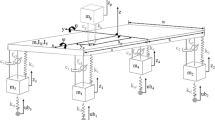Abstract
Due to the coexistence and coupling of continuous variables and discrete events, the vehicle height adjustment process of electronic air suspension system can be regarded as a typical hybrid system. Therefore, the hybrid system theory was applied to design a novel vehicle height control strategy in this paper. A nonlinear mechanism model of the vehicle height adjustment system was established based on vehicle system dynamics and thermodynamic theory for variable-mass gas charge/discharge system. In order to model both the continuous/discrete dynamics of vehicle height adjustment process and the on-off statuses switching of solenoid valves, the framework of mixed logical dynamical (MLD) modelling was used. On the basis of the vehicle height adjustment control strategy, the MLD model of the adjustment process was built by introducing auxiliary logical variables and auxiliary continuous variables. Then, the co-simulation of the nonlinear mechanism model and the MLD model was conducted based on the compiling of HYSDEL. The simulation and experimental results show that the proposed control strategy can not only adjust the vehicle height effectively, but also achieve the on-off statuses direct control of solenoid valves.
Similar content being viewed by others
References
Chen Y K, He J, King M, et al. Effect of driving conditions and suspension parameters on dynamic load-sharing of longitudinalconnected air suspensions. Sci China Tech Sci, 2013, 56: 666–676
Le T D, Kyoung K A. Active pneumatic vibration isolation system using negative stiffness structures for a vehicle seat. J Sound Vib, 2014, 333: 1245–1268
Huang J M, Zhou K K, Xu X, et al. Nonlinear model on leveling procedure of electronically controlled air suspension (in Chinese). J Mech Eng, 2009, 45: 278–283
Masanori H, Seiichi M, Shuichi B, et al. Toyota electronic modulated air suspension system for the 1986 Soarer. IEEE T Ind Electron, 1988, 35: 193–200
Hyunsup K, Hyeongcheo L. Fault-tolerant control algorithm for a four- corner closed-loop air suspension system. IEEE T Ind Electron, 2011, 58: 4866–4879
Xu X, Chen Z Z, Li Z X, et al. Investigation on modeling and control of body height adjustment for bus with electrically controlled air suspension (in Chinese). Aut Tech, 2009, 11: 42–46
Xu X, Chen Z Z, Quan L, et al. Real-time tracking of ride height for bus with electrically controlled air suspension (in Chinese). J Mech Eng, 2011, 47: 136–141
Hyunsup K, Hyeongcheo L. Height and leveling control of automotive air suspension system using sliding mode approach. IEEE T Veh Technol, 2011, 60: 2027–2041
Xu X, Chen L, Sun L Q, et al. Dynamic ride height adjusting controller of ECAS vehicle with random road disturbances. Math Probl Eng, 2013, 2013: 1–9
Zhang J, Lei S, Duan S S. Simulation and experimental research on air suspension couch height control (in Chinese). J Wuhan U Tech, 2012, 34: 123–126
Olsen S G, Bone G M. Model-based control of three degrees of freedom robotic bulldozing. J Dyn Syst-T ASME, 2014, 136: 1–5
Olsen S G, Bone G M. Development of a hybrid dynamic model and experimental identification of robotic bulldozing. J Dyn Syst-T ASME, 2013, 135: 1–10
Wei S M, Uthaichana K, Zefran M, et al. Hybrid model predictive control for the stabilization of wheeled mobile robots subject to wheel slippage. IEEE T Contr Syst T, 2013, 21: 2181–2193
Hodgson S, Le M Q, Tavakoli M, et al. Improved tracking and switching performance of an electro-pneumatic positioning system. Mechatronics, 2012, 22: 1–12
Zhao L F, Yu X M, Qian D C, et al. The effects of EGR and ignition timing on emissions of GDI engine. Sci China Tech Sci, 2013, 56: 3144–3150
Fang Y D, Li D F, FAN Z P, et al. Study on pneumatic-fuel hybrid system based on waste heat recovery from cooling water of internal combustion engine. Sci China Tech Sci, 2013, 56: 3070–3080
Dou H, Chen L, Wang S H, et al. Research on vehicle height adjustment control of electronically controlled closed loop air suspension (in Chinese). Mach Des Manuf, 2014, 9: 171–174
Yin Z H, Khajepour A, Cao D P, et al. A new pneumatic suspension system with independent stiffness and ride height tuning capabilities. Vehicle Syst Dyn, 2012, 50:1735–1746
Zhao W Z, Li Y J, Wang C Y. Robust control of hand wheel torque for active front steering system. Sci China Tech Sci, 2015, 58: 107–116
Zhang L P, Li L, Qi B N, et al. Parameters optimum matching of pure electric vehicle dual-mode coupling drive system. Sci China Tech Sci, 2014, 57: 2265–2277
Ruan X G, Wu X. The skinner automaton: A psychological model formalizing the theory of operant conditioning. Sci China Tech Sci, 2013, 56: 2745–2761
Bemporad A, Morari M. Control of systems integrating logic, dynamics, and constraints. Automatica, 1999, 35: 407–427
Borrelli F, Bemporad A, Fodor M, et al. An MPC/Hybrid system approach to traction control. IEEE T Contr Sys T, 2006, 14: 541–552
Torrisi F D, Bempoard A. HYSDEL—A tool for generating computational hybrid models for analysis and synthesis problems. IEEE T Contr Sys T, 2004, 12: 235–249
Dong L X, Dou L H, Chen J, et al. Hybrid model predictive control for speed control of permanent magnet synchronous motor with saturation. J Con Theor Appl, 2011, 9: 251–255
Author information
Authors and Affiliations
Corresponding author
Rights and permissions
About this article
Cite this article
Sun, X., Chen, L., Wang, S. et al. Vehicle height control of electronic air suspension system based on mixed logical dynamical modelling. Sci. China Technol. Sci. 58, 1894–1904 (2015). https://doi.org/10.1007/s11431-015-5861-9
Received:
Accepted:
Published:
Issue Date:
DOI: https://doi.org/10.1007/s11431-015-5861-9




